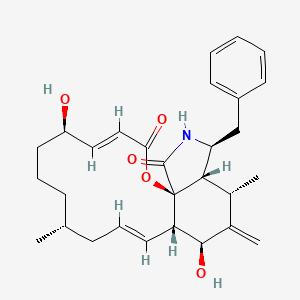| MeSH term | MeSH ID | Detail |
|---|---|---|
| Thrombocytopenia | D013921 | 15 associated lipids |
| Leukemia, Myelogenous, Chronic, BCR-ABL Positive | D015464 | 17 associated lipids |
| Leukemia, Lymphoid | D007945 | 18 associated lipids |
| Lymphoma | D008223 | 18 associated lipids |
| Wounds and Injuries | D014947 | 20 associated lipids |
| Tuberculosis | D014376 | 20 associated lipids |
| Anemia | D000740 | 21 associated lipids |
| Carcinoma 256, Walker | D002279 | 22 associated lipids |
| Hypoxia-Ischemia, Brain | D020925 | 22 associated lipids |
| Medulloblastoma | D008527 | 22 associated lipids |
CYTOCHALASIN B
CYTOCHALASIN B is a lipid of Polyketides (PK) class. Cytochalasin b is associated with abnormalities such as Renal tubular disorder and Chagas Disease. The involved functions are known as Membrane Protein Traffic, inhibitors, Metabolic Inhibition, Biochemical Pathway and Increased Sensitivy. Cytochalasin b often locates in Cytoplasmic matrix, Plasma membrane, Microtubules, Extracellular and Protoplasm. The associated genes with CYTOCHALASIN B are SLC2A2 gene, PFDN5 gene, SLC2A1 gene, OMG gene and SPEN gene. The related lipids are Steroids, Lipopolysaccharides and Liposomes. The related experimental models are Xenograft Model.
Cross Reference
Introduction
To understand associated biological information of CYTOCHALASIN B, we collected biological information of abnormalities, associated pathways, cellular/molecular locations, biological functions, related genes/proteins, lipids and common seen animal/experimental models with organized paragraphs from literatures.
What diseases are associated with CYTOCHALASIN B?
CYTOCHALASIN B is suspected in Renal tubular disorder, Chagas Disease and other diseases in descending order of the highest number of associated sentences.
Related references are mostly published in these journals:
| Disease | Cross reference | Weighted score | Related literature |
|---|
Possible diseases from mapped MeSH terms on references
We collected disease MeSH terms mapped to the references associated with CYTOCHALASIN B
PubChem Associated disorders and diseases
What pathways are associated with CYTOCHALASIN B
There are no associated biomedical information in the current reference collection.
PubChem Biomolecular Interactions and Pathways
Link to PubChem Biomolecular Interactions and PathwaysWhat cellular locations are associated with CYTOCHALASIN B?
Visualization in cellular structure
Associated locations are in red color. Not associated locations are in black.
Related references are published most in these journals:
| Location | Cross reference | Weighted score | Related literatures |
|---|
What functions are associated with CYTOCHALASIN B?
Related references are published most in these journals:
| Function | Cross reference | Weighted score | Related literatures |
|---|
What lipids are associated with CYTOCHALASIN B?
Related references are published most in these journals:
| Lipid concept | Cross reference | Weighted score | Related literatures |
|---|
What genes are associated with CYTOCHALASIN B?
Related references are published most in these journals:
- Am. J. Physiol., Cell Physiol. (2)
- Am. J. Physiol. Endocrinol. Metab. (1)
- Am. J. Physiol. Gastrointest. Liver Physiol. (1)
- Others (8)
| Gene | Cross reference | Weighted score | Related literatures |
|---|
What common seen animal models are associated with CYTOCHALASIN B?
Xenograft Model
Xenograft Model are used in the study 'Endofacial competitive inhibition of the glucose transporter 1 activity by gossypol.' (Pérez A et al., 2009).
Related references are published most in these journals:
| Model | Cross reference | Weighted score | Related literatures |
|---|
NCBI Entrez Crosslinks
All references with CYTOCHALASIN B
Download all related citations| Authors | Title | Published | Journal | PubMed Link |
|---|---|---|---|---|
| Shi W et al. | The nondepolarizing, normokalemic cardioplegia formulation adenosine-lidocaine (adenocaine) exerts anti-neutrophil effects by synergistic actions of its components. | 2012 | J. Thorac. Cardiovasc. Surg. | pmid:22079877 |
| Mueckler M and Makepeace C | Ligand-induced movements of inner transmembrane helices of Glut1 revealed by chemical cross-linking of di-cysteine mutants. | 2012 | PLoS ONE | pmid:22363641 |
| Berendsen AD et al. | Contraction-induced Mmp13 and -14 expression by goat articular chondrocytes in collagen type I but not type II gels. | 2012 | J Tissue Eng Regen Med | pmid:21948715 |
| Orellana JA et al. | Glucose increases intracellular free Ca(2+) in tanycytes via ATP released through connexin 43 hemichannels. | 2012 | Glia | pmid:21987367 |
| Kim EL et al. | Cytotoxic cytochalasins from the endozoic fungus Phoma sp. of the giant jellyfish Nemopilema nomurai. | 2012 | Bioorg. Med. Chem. Lett. | pmid:22483395 |
| Oguri E et al. | Clearance of CD43-capped cells by macrophages: capping alone leads to phagocytosis. | 2012 | Biol. Pharm. Bull. | pmid:22466560 |
| Terashita Y et al. | Latrunculin A can improve the birth rate of cloned mice and simplify the nuclear transfer protocol by gently inhibiting actin polymerization. | 2012 | Biol. Reprod. | pmid:22492972 |
| Ojeda P et al. | Noncompetitive blocking of human GLUT1 hexose transporter by methylxanthines reveals an exofacial regulatory binding site. | 2012 | Am. J. Physiol., Cell Physiol. | pmid:22673619 |
| Bentley PA et al. | Characterization of bovine glucose transporter 1 kinetics and substrate specificities in Xenopus oocytes. | 2012 | J. Dairy Sci. | pmid:22365203 |
| Mace OJ et al. | The regulation of K- and L-cell activity by GLUT2 and the calcium-sensing receptor CasR in rat small intestine. | 2012 | J. Physiol. (Lond.) | pmid:22495587 |
